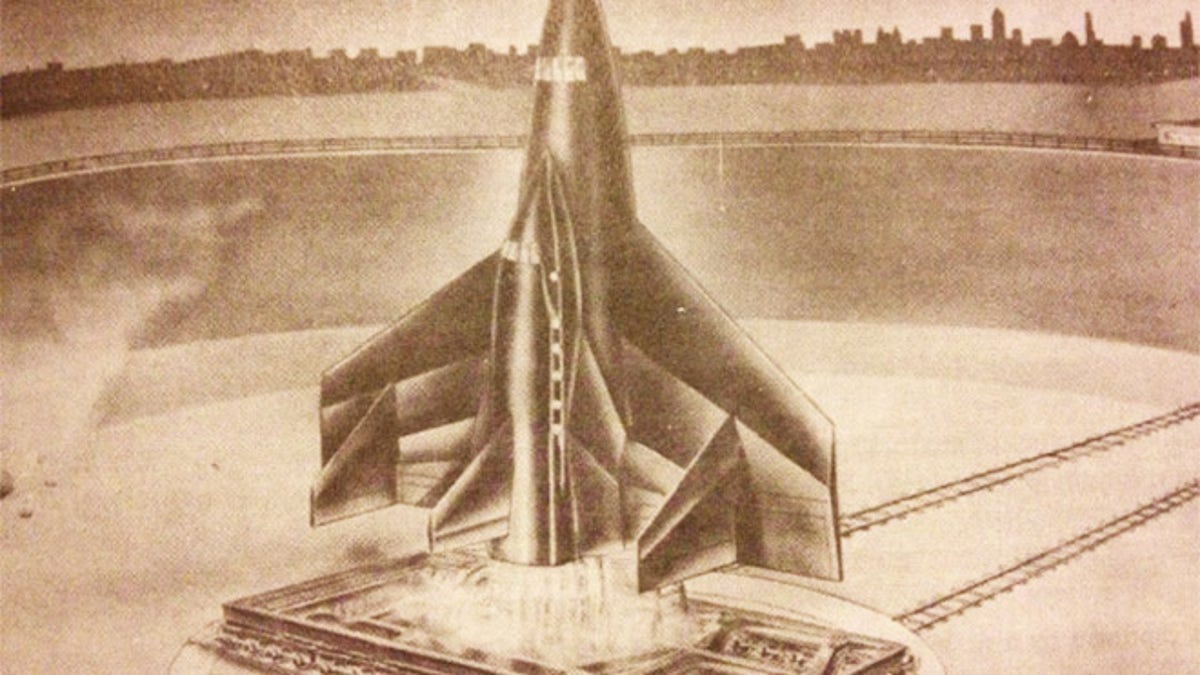
A scan of the original Dornberger spaceplane.
Last month, the German Aerospace Center announced its SpaceLiner.
This still-on-paper hypersonic suborbital spaceplane is theoretically capable of taking up to 50 passengers at a time to destinations halfway across the world in a few hours. It’s an exciting prospect, seeing the curvature of the Earth during a business trip.
But it isn’t a new idea. A host of science fiction writers have explored this, as did Walter Dornberger, former director of the V-2 program at Peenemunde in Germany, in 1956.
In 1952, Dornberger was a new immigrant to the United States working as a guided missile consultant for Bell Aircraft in Ohio. He pitched the idea of a hypersonic manned glider to the Air Force as an efficient and reusable precision bomber. The Air Force, intrigued, pursued the idea; it became the basis of the failed Dyna-Soar program. But for Dornberger, a hypersonic gliding bomber was a step on the way to suborbital hypersonic air travel.
ANALYSIS: When the Dyna-Soar Went Extinct
Inspired by the rapid growth of aviation – from the Wright brothers’ first flight to Mach 2 in half a century – he imagined a future where hypersonic passenger flights would be commonplace in another 25 years. But the first flights could be sooner. Writing in 1956, he saw that the nation had the technology to start exploring the world of hypersonic air travel with glider mounted on boosters. He called them Ultra Planes, and imagined them taking off from commercial airports around the world.
A glider would be mounted on the “back” of a booster such that the flat, gliding bottoms of both vehicles faced the same way. Once mated, the 90-foot tall pair would be turned vertically and loaded on a train that would carry it, by rail, to its underground launch canyon – image a missile silo big enough for crews to access both vehicles for things like fueling and maintenance. Passengers would arrive at the canyon, which would have an ordinary gate number, by bus since it would be too risky to connect a launch canyon to the terminal by jetway.
With the vehicle ready, the crew and passengers would board, the latter sitting in swiveling chairs that would keep them upright throughout the journey. Once their seat belts were firmly fastened, the booster would roar to life and launch, carrying the glider aloft with it.
ANALYSIS: How Neil Armstrong Saved the Dyna-Soar
For the first minute and a half, the glider’s pilot would be in control of both vehicles; the booster’s skeleton crew would be on standby. Then the stages would separate. The glider would slide off guide rails on the booster’s “back” and the pilot would ignite its engine. The glider would rocket up to 140,000 feet at a top speed of 8,400 miles per hour. At the same time, the booster’s crew would take control of their vehicle and return to the airport for refueling and launch with another glider in tow.
Pilot-controlled sun filters on the window’s would ensure passengers had a safe view of the curvature of the Earth as the glider reached its peak altitude. Then, as dictated by the flight plan, the glider’s pilot would shut off its engine and begin a steady glide his designated airport. The remaining ride would be silent and pleasant with stunning views unhampered by clouds out of every window. Stars that we never see from Earth would be as bright as the moon.
The glider would land, unpowered, like a traditional airplane on a runway. Passengers would disembark by a rolling stairway right onto the tarmac then the glider would be towed to a launch canyon where it would be mated to another booster and fueled for its next launch.
ANALYSIS: NASA’s Next Capsule to Land Like a Helicopter?
The few details on the SpaceLiner suggest it will follow more or less this idea laid out by Dornberger in the 1950s. The SpaceLiner will launch passengers up to 50 miles high at Mach 24 (roughly the design limit of Dyna-Soar) before gliding in at 15,000 mph for a runway landing. SpaceLiner’s project coordinator Martin Sippel expects to start gathering funds in 10 years an to have full operations up and running by 2050.
Sippel’s timeline is about the same as Dornberger’s was in 1956, but hopefully the SpaceLiner will have more luck than the ultra planes. Because traveling through (near) space as a regular airline passenger would be absolutely incredible.




















